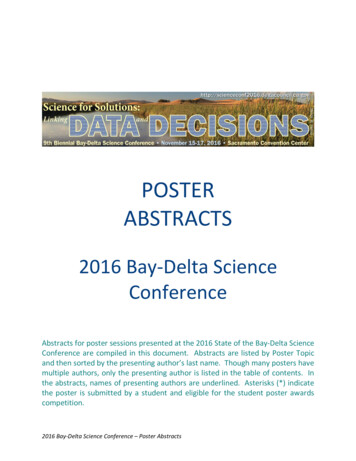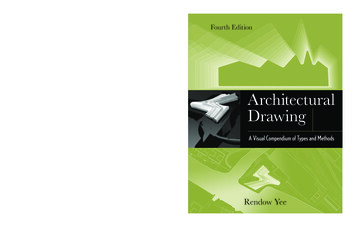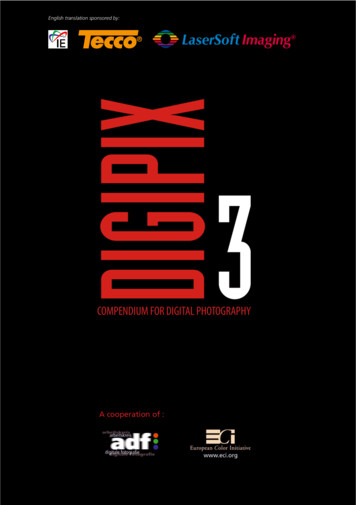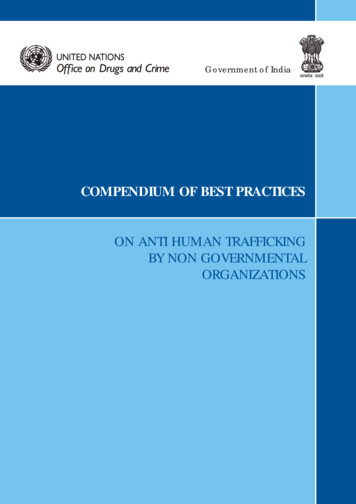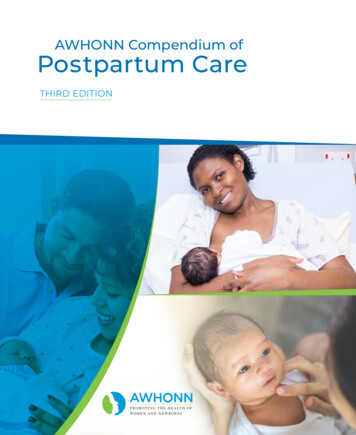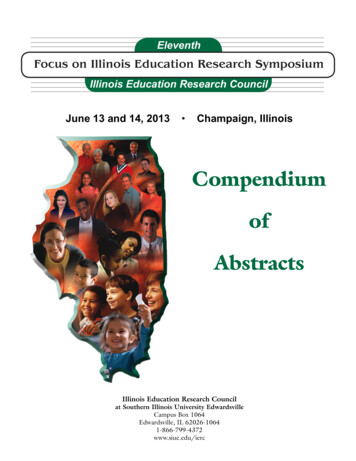
Transcription
EleventhFocus on Illinois Education Research SymposiumIllinois Education Research CouncilJune 13 and 14, 2013 Champaign, IllinoisCompendiumofAbstractsIllinois Education Research Councilat Southern Illinois University EdwardsvilleCampus Box 1064Edwardsville, IL 62026-10641-866-799-4372www.siue.edu/ierc
Abstracts of Symposium PresentationsArranged by SessionCONCURRENT SESSION 1THURSDAY, JUNE 132:15 – 3:15 PM1A - Beginning EarlyThe Birth-to-College Collaborative’s Approach to Job-Embedded ProfessionalDevelopment and Alignment: Professional Learning Communities .1Amanda Stein, The Ounce of Prevention Fund and Teyona James-Harris, The Urban EducationInstitute/University of Chicago Charter SchoolsHow Are They Doing Now? Longitudinal Follow-up Study of QualityEarly Education Recipients .2Amanda Stein and Jacqueline Robinson, The Ounce of Prevention FundSchool Attendance Among Chicago Public Schools’ Youngest Students:Understanding the Causes of Preschool Absenteeism and Its Relationship toLearning Outcomes .3Stacy Ehrlich, Julia Gwynne, Amber Stitziel Pareja, and Elaine Allensworth, University of ChicagoConsortium on Chicago School Research1B - High School to College ReportingEffects of High School Coursework on College Placement & Success .4Matthew Crull and Kevin Fuss, Kishwaukee CollegeEvaluation of the Illinois High School to College Success Report .5Brenda Klostermann, Illinois Education Research Council and Sean Cameron, Southern IllinoisUniversity Carbondale1C - Student Support & Engagement in Higher EducationAdvising Matters: An Institutional Assessment of Advising Resources .6Patricia Inman and Celina Sima, University of Illinois at ChicagoStudent Engagement in Higher Education: Implications for Policy .7M Cecil Smith, John Schwartz, David A. Walker, and Michelé Robinson, Northern IllinoisUniversity, Amy D. Rose and Amy Hitchcock, Seattle University, and Jovita Ross-Gordon, TexasState University-San Marcosi
CONCURRENT SESSION 2THURSDAY, JUNE 133:30 – 4:30 PM2A - Longitudinal Data SystemsSeeking Excellence and Diversity: How Stages in the Pipeline from High Schoolto K-12 Teaching Affect the Composition of New Teachers .8Brad White and Eric Lichtenberger, Illinois Education Research Council and Karen DeAngelis,University of RochesterWhen Worlds Collide: Research, Policy, and Educational Implications for StateResearch Agendas .9Allison Witt, Debra Bragg, and Matthew Linick, University of Illinois at Urbana-Champaign2B - Underrepresented Students in Higher EducationConcentrated Opportunity?: Enrollment and Attainment Trends Among AfricanAmerican and Latino Males Attending Community Colleges in Illinois.10Lorenzo D. Baber and Edmund Graham, University of Illinois at Urbana-ChampaignPredicting Likelihood of College Graduation for Low-Income andUnder-Represented Students.11Susan Gershenfeld, Denice Ward Hood, and Min Zhan, University of Illinois at Urbana-Champaign2C - High School EffectsThe Educational Benefits of Attending High-Performing High Schools .12Paul Moore, Marisa de la Torre, and Elaine Allensworth, University of Chicago Consortium onChicago School ResearchWho Fails Algebra, Who Attends Summer School Credit Recovery Classes, andWho Recovers the Credit? .13Amber Stitziel Pareja and Elaine Allensworth, University of Chicago Consortium on ChicagoSchool Researchii
POSTER SESSIONSTHURSDAY, JUNE 134:45 - 5:45 PMBeing a Gifted Adolescent Girl in the School House: Making Sense of Her World .14Julie Devaud, DePaul UniversityCharacteristics of Successful Teacher Mentoring .15John Cook, Governors State UniversityEnhancing the Quality of Early Math Instruction in Community College EarlyChildhood Education Programs .16Lisa Ginet and Emma Wellman, Erikson InstituteEnvisioning New Landscapes: Chicago Teachers Reflect on Three Yearsof an Arts Partnership.17Louanne Smolin and Della Leavitt, LIS Research Consulting and Joseph Spilberg, Chicago ArtsPartnerships in EducationEvaluation of an Early Math Intervention and Development Project .18Amanda Stein and Elizabeth Rothkopf, The Ounce of Prevention Fund and Jie-Qi Chen,Erikson InstituteAn Examination of Beliefs and Perspectives about Teaching Mathematics in EarlyChildhood Classrooms .19Sham’ah Md-Yunus and Geena Anselmo, Eastern Illinois UniversityExamining Culturally Responsive Pedagogy in Multi-Ethnic NinthGrade Classrooms .20Andrew Brake and Hannah Graham, University of ChicagoExamining Quality of Mathematics Teaching in Early Childhood Classrooms .21Bilge Cerezci, Jeanine Brownell, and Jennifer McCray, Erikson InstituteFocusing on the Whole Teacher in Teacher Professional Development .22Jie-Qi Chen and Jennifer McCray, Erikson InstituteHow Do Student Characteristics and Environmental Factors Influence aCommunity College Student’s Decision to Enroll In-District or Out-of-District? .23Nick Zyznieuski, Illinois Education Research CouncilIntegrating Conceptions of Science Inquiry across University andElementary Classrooms .24Eun Kyung Ko, Alan Rossman, and Diane Salmon, National-Louis UniversityIntegrating Curriculum for Academic Growth .25Jeanne Okrasinski, Eastern Illinois University and Julia Colombo, Mattoon Middle Schooliii
POSTER SESSIONSTHURSDAY, JUNE 134:45 - 5:45 PMInvestigating Professional Self-Efficacy Development in Pre-Service Teachers .26Stephen Lucas and Catherine Polydore, Eastern Illinois UniversityA Look at Teachers’ Pedagogical Content Knowledge of Early Mathematics .27Yinna Zhang and Jie-Qi Chen, Erikson InstituteMaster of Science in Middle School Mathematics Education (MSME):An Examination of Program Outcomes and Effectiveness .28Nayantara Abraham and Jonya Leverett, Loyola University ChicagoThe Relationship of Neighborhood Crime to Post-Secondary EducationalAttainment in Illinois: A Longitudinal Study of the High School Class of 2002 .29Robert Polacheck, Northern Illinois University and Janet K. Holt, Illinois Education ResearchCouncilRelaxation Skills & High Stakes Testing: Role of SES & Envionmental Factors onAnxiety Levels.30Heidi Larson, Sarah Puchalski, J. Adriane Tschantz, Rob McKinney, Luz Lomeli, Alyssa Swan, andDaniel Osterloo, Eastern Illinois UniversityTechnology and UDL in Urban Classrooms: An Examination of USTEP StudentTeachers’ Perception and Use of Technology for Differentiated Instruction .31Xiuwen Wu and Kate Zilla, National Louis UniversityTrends in Students’ Confidence of Future Majors and Occupations: LessonsLearned from the Illinois High School Class of 2002-2005 .32Casey George-Jackson, University of Illinois at Urbana-Champaign and Eric Lichtenberger,Illinois Education Research Counciliv
CONCURRENT SESSION 3FRIDAY, JUNE 149:30 - 10:30 AM3A - Teacher Support and EvaluationDesigning and Implementing the Next Generation of Teacher Evaluation Systems:Lessons Learned from Case Studies in Five Illinois Districts .33Susan Sporte, University of Chicago Consortium on Chicago School Research and Brad White,Illinois Education Research CouncilImpact of Labor-Management Collaborations on Teaching and Learning: Findingsfrom the Great Lakes Teacher Union Reform Network (GL TURN)Evaluation Study .34Mary McDonald, Consortium for Educational Change and Sara Kraemer, Wisconsin Center forEducation ResearchWhen Needs and Funding Fail to Intersect .35Lynn Sikma, Jason Swanson, Alexis Jones, and Patricia Brady, Illinois New Teacher Collaborative,University of Illinois at Urbana-Champaign3B - Improving Performance MetricsApples to Apples: An Alternative Look at Chronic Gaps in Achievement andInstructional Effectiveness in Chicago and All Illinois excluding Chicago .36Paul Zavitkovsky, University of Illinois at ChicagoAn Inventory of Definitions and Measures of College Quality .37Jennifer Stephan, Lisa Hoogstra, Elisabeth Davis, Alicia Garcia, and Shazia Miller,American Institutes for Research3C - College Enrollment & CompletionThe Community College Penalty and Bachelor’s Degree Completion:Fact or Fiction? .38Eric Lichtenberger, Illinois Education Research Council and Cecile Dietrich, Research ConsultantThe Impact of Dual Credit on College Enrollment and College Completion forUnderrepresented Students in Illinois .39Jason Taylor, University of Illinois at Urbana-Champaignv
CONCURRENT SESSION 4FRIDAY, JUNE 1410:45 - 11:45 AM4A - College Student PathwaysComparing the Bachelors Completion Rates of Native Students and TransferStudents using Multiple Informational Sources .40Eric Lichtenberger, Illinois Education Research Council and Liz Sanders and Gerry McLaughlin,DePaul UniversityMigration of Illinois College-bound Students .41James Sconing, ACTA Strategic Look at Enrolling Successful Transfer Students .42Connie Castellucci, Lois Bishop, Liz Sanders, and Gerry McLaughlin, DePaul University4B - Technology Advances in EducationMethods for Stimulating Intellectual Curiosity and Affecting Deep Learningin the Classroom and the Impact of Modern Technology in Education .43M. Vali Siadat, Euguenia Peterson, Cyrill Oseledets, Ming-Jer Wang, Gyo Quan (Jack) Zhang, andLuissette Hernandez-Medina, Richard J. Daley CollegeThe Virtual Laboratory School at Northern Illinois University:A Distributed P20 Pipeline .44Lara Luetkehans, Sharon Smaldino, Rebecca Hunt, Mary Baker, and Cassandra Hughes,Northern Illinois University4C - Advancing Data and Assessment SystemsDeveloping a Statewide System of Local Assessment Support .45Mary O’Brien, Diana Zaleski, and Angela Chamness, Illinois State Board of EducationEducation Lessons Learned with Longitudinal Data Systems andQuasi-Experimental Design.46Matthew Linick and Joseph Robinson, University of Illinois at Urbana-ChampaignREL Midwest EdMaps: Assessing Education Data Geospatially .47Matt Burke, American Institutes for Researchvi
Index of AuthorsAbraham, Nayantara . 28Hughes, Casandra. 44Rossman, Alan . 24Allensworth, Elaine . 3, 12, 13Hunt, Rebecca . 44Rothkopf, Elizabeth . 18Anselmo, Geena. 19Inman, Patricia . 6Salmon, Diane . 24Baber, Lorenzo D. . 10James-Harris, Teyona . 1Sanders, Liz . 40, 42Baker, Mary . 44Jones, Alexis . 35Schwartz, John . 7Bishop, Lois. 42Klostermann, Brenda . 5Sconing, James . 41Brady, Patricia . 35Ko, Eun Kyung. 24Siadat, M. Vali . 43Bragg, Debra . 9Kraemer, Sara . 34Sikma, Lynn . 35Brake, Andrew . 20Larson, Heidi . 30Sima, Celina . 6Brownell, Jeanine. 21Leavitt, Della . 17Smaldino, Sharon. 44Burke, Matt . 47Leverett, Jonya . 28Smith, M Cecil . 7Cameron, Sean . 5Lichtenberger, Eric . 8, 32, 38, 40Smolin, Louanne I. . 17Castellucci, Connie . 42Linick, Matthew . 9, 46Spilberg, Joseph . 17Cerezci, Bilge . 21Lomeli, Luz . 30Sporte, Susan . 33Chamness, Angela. 45Lucas, Stephen. 26Stein, Amanda . 1, 2, 18Chen, Jie-Qi . 18, 22, 27Luetkehans, Lara . 44Stephan, Jennifer L. . 37Colombo, Julia . 25McCray, Jennifer . 21, 22Swan, Alyssa . 30Cook, John . 15McDonald, Mary . 34Swanson, Jason . 35Crull, Matthew . 4McKinney, Rob. 30Taylor, Jason . 39Davis, Elisabeth . 37McLaughlin, Gerry . 40, 42Tschantz, J. Adriane. 30de la Torre, Marisa . 12Md-Yunus, Sham’ah . 19Walker, David A. . 7DeAngelis, Karen . 8Miller, Shazia . 37Wang, Ming-Jer . 43Devaud, Julie . 14Moore, Paul. 12Wellman, Emma . 16Dietrich, Cecile, . 38O’Brian, Mary . 45White, Brad . 8, 33Ehrlich, Stacy. 3Okrasinski, Jeanne . 25Witt, Allison . 9Fuss, Kevin . 4Oseledets, Cyrill. 43Wu, Xiuwen . 31Garcia, Alicia . 37Osterloo, Daniel . 30Zaleski, Diana . 45George-Jackson, Casey. 32Pareja, Amber Stitziel. 3, 13Zavitkovsky, Paul . 36Gershenfeld, Susan. 11Peled, Ofra . 24Zhan, Min . 11Ginet, Lisa . 16Peterson, Euguenia . 43Zhang, Gyo Quan (Jack) . 43Graham, Edmund . 10Polacheck, Robert. 29Zhang, Yinna . 27Graham, Hannah . 20Polydore, Catherine . 26Zilla, Kate . 31Gwynne, Julia . 3Puchalski, Sarah . 30Zyznieuski, Nick . 23Hernandez-Medina, Luissette . 43Robinson, Jacqueline . 2Hitchcock, Amy . 7Robinson, Joseph. 46Holt, Janet K. . 29Robinson , Michelé . 7Hood, Denice Ward. 11Rose, Amy D. . 7Hoogstra, Lisa . 37Ross-Gordon, Jovita . 7vii
viii
The Birth-to-College Collaborative’s Approach to Job-Embedded ProfessionalDevelopment and Alignment: Professional Learning CommunitiesAmanda Stein, PhD, Senior Research Associate, Early Childhood EducationThe Ounce of Prevention FundTeyona James-Harris, PLC Coordinator, Consultant to Birth-To-College CollaborativeDirector of Early Childhood Curriculum & Innovation, Woodlawn Children’s Promise CommunityThe Urban Education Institute/University of Chicago Charter SchoolsThe Ounce of Prevention Fund (the Ounce) and the Urban Education Institute of the University of Chicago (UEI)have formed a Collaborative designed to:1) develop and engage in a comprehensive, transformative approach to professional development that results in anew, shared belief system and set of values, behaviors, and practices that will demonstrably improve outcomesfor children during their first eight years of life, and their families, and2) launch and refine a coordinated, high-quality, birth-to-age-eight model of public education that establishesconsistent expectations for children’s development and learning, standards, curriculum, assessment, and familysupports from birth to grade three.The purpose of creating this Birth-To-College (BTC) model of public education in Illinois is to lay a strong foundationand seamless pathway to accelerate children’s development by creating, implementing, and evaluating newly alignedsystems to provide vulnerable children, their families, and the professionals who support them with an effective, cohesivecontinuum of education and support. Professional Learning Communities (PLCs) have been established are our primarymechanism of job-embedded, collaborative professional development and alignment. PLCs engage staff in group-basedinquiry with their peers about aligning evidence-based, best practices through the use of standards, data, and/or theempirical evidence-base. This presentation will explore the evidence, lessons learned, and policy implications of PLCs asa mechanism to advance a coordinated, high-quality model of public education beginning at birth within the work ofthe BTC Collaborative.MethodologyDescription of Sites: The Ounce operates Educare Chicago serving 149 children and their families in a full-day, fullyear high-quality early education program beginning at birth and continuing to age five. The four campuses of UEI’sUniversity of Chicago Charter Schools (UCCS) create a preK-12th grade pathway for families residing on the south sideof Chicago. North Kenwood/Oakland (NKO; preK-5th), Donoghue (preK-5th), Carter G. Woodson (6th-8th), andWoodlawn (6th-12th) enroll more than 1700 students. 98% of the students are African American and more than 80%are eligible for free or reduced-price meals.Project Design & Sample: As part of our transformative approach to professional development, six PLCs, were establishedto bring together over 60 birth-to-grade three teachers, family support staff, and administrators to advance alignment inkey areas: assessment, language and literacy, math, social-emotional learning, transitions, and families. These PLCs areunique in that: they: have membership that crosses three schools, are interdisciplinary, span grade/development levelsand are topic-based.Data Collection and Analysis MethodsStill in the early stages of development and implementation, we are taking a primarily qualitative approach to data collectionand analysis in our work; with two mixed-method surveys of PLC members being a major source of formative evaluationdata. Supplemental data such as archival BTC documentation produced and compiled by staff have been analyzed tosupport themes, concepts, and theories derived from documentation notes analysis.Summary of FindingsWe will report progress on the study goals, describe findings from formative evaluation, and share lessons learned from ouralignment work to create a BTC continuum of public education through engagement in a comprehensive, transformativeapproach to professional development. Reported findings will be from two years of work on a 3-year project (September1, 2011 – August 31, 2014) funded by W. K. Kellogg Foundation, the Robert R. McCormick Foundation, and theFoundation for Child Development.1
How Are They Doing Now? Longitudinal Follow-up Study of Quality Early EducationAmanda Stein, PhD, Senior Research Associate, Early Childhood EducationJacqueline Robinson, Research AssistantThe Ounce of Prevention FundPurpose and goals of the studyThe Educare Chicago Elementary School Follow-Up Study (FUS) is an ongoing, longitudinal, exploratory and descriptivestudy designed 1) to examine how effectively the Educare model of early childhood education prepares young childrenand their families from low-income backgrounds for school success; 2) to learn about the school environments andexpectations of the primary grade teachers; 3) and to discover implications from these findings to inform programimprovement decisions.Theoretical/research backgroundThe ‘fade out’ of early education effects from pre-school into elementary school is well known and has surfaced mostrecently in the news with the release of the Head Start Impact Study’s third grade findings, which show fade out ofacademic effects in first and third grades. From its inception, the Follow-Up Study intended to look for fade out effectsin elementary school.The alignment of preschool to kindergarten and through third grade has also enjoyed a recent focus in research andpolicy. Such alignment has potential to ease the transition from pre-kindergarten programs to elementary school for bothchildren and parents and has been associated with better student outcomes. The Follow-Up Study therefore, intentionallyexamines the transition from early education and tracks progress through elementary school experiences in order tobetter prepare children and parents for the transition into elementary school.In the field of early learning and education, there is a growing expectation that programs use research-based practicesand data to drive decision making, and accountability. This study is an example of how data collected on progress afterleaving a program can be a rich source for program improvement.Summary of findingsPrevious analyses have shown that: over 75% of Educare graduates are rated as average or excellently prepared for kindergarten through third grade;reading and math grades follow a similar pattern through third grade between 67% (reading) and 75% (math) are meeting or exceeding state standards at third grade special education services and grade retention are significantly lower than CPS average no fade out on average on standardized measures from the end of Educare participation to the end of third grade nearly 2/3 of Educare graduates’ parents in the study are rated by elementary school teachers as being activelyinvolved in their child’s schoolingThese analyses will be updated using current school year data.2
School Attendance Among Chicago Public Schools’ Youngest Students: Understandingthe Causes of Preschool Absenteeism and Its Relationship to Learning OutcomesStacy Ehrlich, PhD, Senior Research AnalystJulia Gwynne, PhD, Senior Research AnalystAmber Stitziel Pareja, PhD, Senior Research AnalystElaine Allensworth, PhD, Interim Executive DirectorUniversity of Chicago Consortium on School ResearchNewly-emerging research suggests that chronic absenteeism is a significant problem among very young students, with11% of kindergarteners across the nation chronically absent (Romero & Lee, 2007). The impact of high absenteeism onlearning outcomes is more detrimental for high-poverty students, who are most likely to be chronically absent (Ready,2010). Our research extends this work to look at absenteeism among preschool students enrolled in the Chicago PublicSchools (CPS) and focuses on four research questions:1) What does attendance look like in preschool and early grades, and who is most likely to miss more school?2) How is preschool attendance related to preschool learning outcomes?3) How is preschool attendance related to outcomes in later grades?4) Why are students absent from preschool?At IERC 2012, we presented preliminary findings on the first and fourth question. We showed that chronic absenteeismis very high among preschool students and that minority students were much more likely to be chronically absent thanwhite or Asian students. This year, we share our remaining findings.Preschool attendance is related to outcomes, both in preschool and in later years. Students who are chronically absenthave lower levels of basic math skills and are less able to identify letters and their corresponding sounds by the end ofpreschool than those who attend regularly, even after taking into account prior skill levels. These chronically absentstudents start kindergarten behind their peers and have higher chances of being chronically absent in future years. Themultiple years of chronic absenteeism is associated with lower outcome scores on standardized test scores in 2nd grade.Aside from children being sick, families also face a range of obstacles to getting their children to school regularly, includingchild chronic illness, transportation and child care difficulties, and other family-related reasons. Minority students missmore school due to all of these reasons than white students do, and African American students are more likely to comefrom backgrounds that may make it harder to managing these obstacles: single-parent families, and families with lowerparental education and poorer health.Addressing the high rates of absenteeism beginning in the early years may help alleviate the high rates of absenteeism wesee as children get older. While there are too many chronically absent preschool children to target each one individually,our findings may guide schools in thinking about higher-level supports, such as partnerships with local communityorganizations. Schools and communities could come together to understand the particular obstacles that parents intheir community face, and work together to convey the importance of regular school attendance at the earliest ages andprovide supports that families need.3
Effects of High School Coursework on College Placement & SuccessMatthew Crull, Director of ResearchKevin Fuss, Associate Vice President, Institutional EffectivenessKishwaukee CollegeIntroductionThe Illinois High School to College Success Report yielded data to facilitate discussions between local high schools andpost-secondary education institutions (IBHE 2010). The Research Office of Kishwaukee College has regularly evaluatedincoming high schools students to analyze placement and performance in math, reading, and English. These data areshared with the local high school superintendents annually. Formal meetings were held in 2010 and 2011 between localhigh school administrators and Kishwaukee College administrators. It was agreed that specific coursework in each highschool needed to be analyzed to determine how it affected College placement and performance.MethodsAfter signing data exchange agreements, recent graduates from participating local high schools who immediately attendedKishwaukee College were identified using the College annual enrollment file (A1) and logged into spreadsheets by theResearch Office. These spreadsheets contained names, dates of birth, and high school graduation year. Spreadsheetswere exchanged via institutional emails. High school personnel logged students’ curriculum and performance in math,reading, and English during their time in attendance. Then these data were returned to Kishwaukee College. COMPASSplacement scores and first related course performance at Kishwaukee College were merged up with the students. Studentswere analyzed based on which high school courses they were able to successfully complete with a grade of “C or higher”and progress through their high school curriculum. Individual comprehensive reports were designed to illustrate eachhigh schools educational paths and how they affected placement and performance at Kishwaukee College.ResultsThe reports illustrated several highlights including successful completion of pre-calculus in high school increased thelikelihood of College-level placement by 41.2% to 78.1% versus Algebra II completion depending on the high school.Successful completion of an advanced versus a standard English class in senior year increased College-level placementby as much as 10%. Additional differences were found between high school institutions regarding the impact of certaincoursework.ConclusionsPrimary implications for education policy at the high school level included using established benchmarks to determine theefficacy of math, English, and reading coursework pathways. Using these data, secondary schools can justify emphasizingmore rigorous course requirements for graduates to improve and promote College readiness. Reports were disseminatedto counselors, faculty, and parents of students at the high schools to encourage certain course-taking behavior. In somecases, reports were given to feeder middle schools to illustrate where students needed to be coming into high schoolfor College success. Additionally, Kishwaukee College utilized the data to analyze COMPASS placement proportionsbased on high school coursework and special student population needs. Follow-up reports were planned for the future.4
Evaluation of the Illinois High School to College Success ReportBrenda Klostermann, PhD, Associate Director for
June 13 and 14, 2013 Champaign, Illinois Compendium of Abstracts Eleventh Illinois Education Research Council Focus on Illinois Education Research Symposium Illinois Education Research Council
